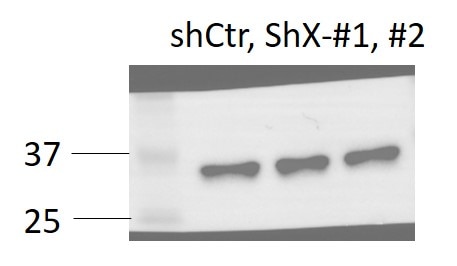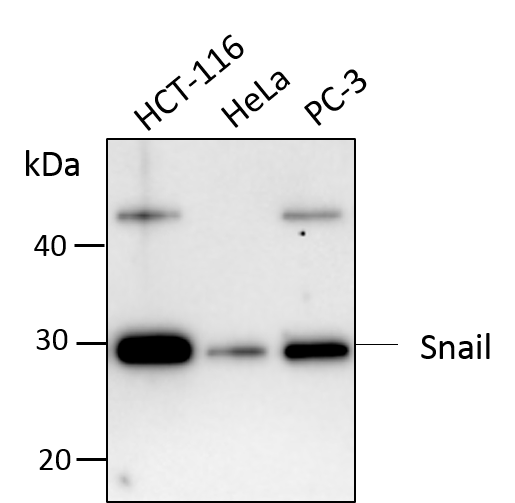Human Snail Antibody Summary
Pro2-Arg264
Accession # O95863
Applications
Please Note: Optimal dilutions should be determined by each laboratory for each application. General Protocols are available in the Technical Information section on our website.
Scientific Data
 View Larger
View Larger
Detection of Human Snail by Western Blot. Western blot shows lysates of A549 human lung carcinoma cell line and JEG-3 human epithelial choriocarcinoma cell line. PVDF membrane was probed with 0.5 µg/mL of Goat Anti-Human Snail Antigen Affinity-purified Polyclonal Antibody (Catalog # AF3639) followed by HRP-conjugated Anti-Goat IgG Secondary Antibody (Catalog # HAF109). A specific band was detected for Snail at approximately 29 kDa (as indicated). This experiment was conducted under reducing conditions and using Immunoblot Buffer Group 1.
 View Larger
View Larger
Detection of Snail-regulated Genes by Chromatin Immunoprecipitation. Jurkat human acute T cell leukemia cell line treated with 50 ng/mL PMA and 200 ng/mL calcium ionomycin for 30 minutes was fixed using formaldehyde, resuspended in lysis buffer, and sonicated to shear chromatin. Snail/DNA complexes were immunoprecipitated using 5 µg Goat Anti-Human Snail Antigen Affinity-purified Polyclonal Antibody (Catalog # AF3639) or control antibody (Catalog # AB-108-C) for 15 minutes in an ultrasonic bath, followed by Biotinylated Anti-Goat IgG Secondary Antibody (Catalog # BAF109). Immunocomplexes were captured using 50 µL of MagCellect Streptavidin Ferrofluid (Catalog # MAG999) and DNA was purified using chelating resin solution. TheE-Cadherinpromoter was detected by standard PCR.
 View Larger
View Larger
Snail in A549 Human Cell Line. Snail was detected in immersion fixed A549 human lung carcinoma cell line treated with Recombinant Human TGF-beta 1 (left panel, Catalog # 240-B) or untreated (right panel) using Goat Anti-Human Snail Antigen Affinity-purified Polyclonal Antibody (Catalog # AF3639) at 10 µg/mL for 3 hours at room temperature. Cells were stained using the NorthernLights™ 557-conjugated Anti-Goat IgG Secondary Antibody (red; Catalog # NL001) and counterstained with DAPI (blue). Specific staining was localized to nuclei. View our protocol for Fluorescent ICC Staining of Cells on Coverslips.
 View Larger
View Larger
Detection of Snail in A549 Human Cell Line by Flow Cytometry. A549 human lung carcinoma cell line was stained with Goat Anti-Human Snail Antigen Affinity-purified Polyclonal Antibody (Catalog # AF3639, filled histogram) or isotype control antibody (Catalog # AB-108-C, open histogram), followed by Fluorescein-conjugated Anti-Goat IgG Secondary Antibody (Catalog # F0109). To facilitate intracellular staining, cells were fixed and permeabilized with FlowX FoxP3 Fixation & Permeabilization Buffer Kit (Catalog # FC012). View our protocol for Staining Intracellular Molecules.
 View Larger
View Larger
Detection of Human Snail by Western Blot SerpinA1 was regulated by SnailA. DLD-1 and SW480 cells were transfected with pcDNA-Snail (Snail), control vector pcDNA (vector), Snail siRNA (siSnail), or nontargeting siRNA (siNT), and Snail and serpinA1 protein levels were evaluated by western blot analysis. B. DLD-1 and SW480 cells were transfected with pcDNA-serpinA1 (serpinA1), control vector pcDNA (vector), serpinA1 siRNA (siSerpinA1), or nontargeting siRNA (siNT), and western blot analysis was performed for detection of Snail and SerpinA1 expression. C. DLD-1 and SW480 cells were transfected with pcDNA-Snail (Snail) or control vector pcDNA (vector), and ChIP assays were performed. The presence of the serpinA1 promoter (−516/−4) was verified in immunoprecipitates with either mouse IgG or anti-Snail antibodies, and assay inputs were analyzed using real-time PCR. The samples were loaded on agarose gels. D. Data show promoter enrichment in the anti-Snail immunoprecipitate relative to IgG. Image collected and cropped by CiteAb from the following publication (https://pubmed.ncbi.nlm.nih.gov/26015410), licensed under a CC-BY license. Not internally tested by R&D Systems.
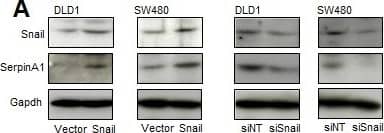 View Larger
View Larger
Detection of Human Snail by Western Blot SerpinA1 was regulated by SnailA. DLD-1 and SW480 cells were transfected with pcDNA-Snail (Snail), control vector pcDNA (vector), Snail siRNA (siSnail), or nontargeting siRNA (siNT), and Snail and serpinA1 protein levels were evaluated by western blot analysis. B. DLD-1 and SW480 cells were transfected with pcDNA-serpinA1 (serpinA1), control vector pcDNA (vector), serpinA1 siRNA (siSerpinA1), or nontargeting siRNA (siNT), and western blot analysis was performed for detection of Snail and SerpinA1 expression. C. DLD-1 and SW480 cells were transfected with pcDNA-Snail (Snail) or control vector pcDNA (vector), and ChIP assays were performed. The presence of the serpinA1 promoter (−516/−4) was verified in immunoprecipitates with either mouse IgG or anti-Snail antibodies, and assay inputs were analyzed using real-time PCR. The samples were loaded on agarose gels. D. Data show promoter enrichment in the anti-Snail immunoprecipitate relative to IgG. Image collected and cropped by CiteAb from the following publication (https://pubmed.ncbi.nlm.nih.gov/26015410), licensed under a CC-BY license. Not internally tested by R&D Systems.
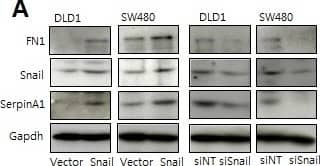 View Larger
View Larger
Detection of Human Snail by Western Blot Snail and serpinA1 promoted tumor progression through fibronectinA. DLD-1 and SW480 cells were transfected with pcDNA-Snail (Snail), control vector pcDNA (vector), Snail siRNA (siSnail), or nontargeting siRNA (siNT), and Snail, serpinA1, and fibronectin protein levels were evaluated by western blot analysis. B. DLD-1 and SW480 cells were transfected with pcDNA-serpinA1 (SerpinA1), control vector pcDNA (vector), serpinA1 siRNA (siSerpinA1), or nontargeting siRNA (siNT), and Snail, serpinA1, and fibronectin protein levels were evaluated by western blot analysis. C. DLD-1 and SW480 cells were transfected with pcDNA-fibronectin (Fibronectin), control vector pcDNA (vector), fibronectin siRNA (siFibronectin), or nontargeting siRNA (siNT), and Snail, serpinA1, and fibronectin protein levels were evaluated by western blot analysis. D., E. Invasion and migration assays were performed using transfected cells. Representative data are shown for cells that invaded (top) and migrated (bottom) in the presence of 1% FBS. *P < 0.05. Image collected and cropped by CiteAb from the following publication (https://pubmed.ncbi.nlm.nih.gov/26015410), licensed under a CC-BY license. Not internally tested by R&D Systems.
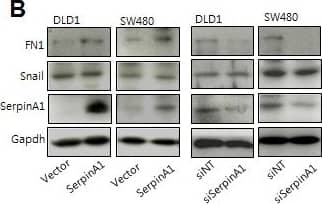 View Larger
View Larger
Detection of Human Snail by Western Blot Snail and serpinA1 promoted tumor progression through fibronectinA. DLD-1 and SW480 cells were transfected with pcDNA-Snail (Snail), control vector pcDNA (vector), Snail siRNA (siSnail), or nontargeting siRNA (siNT), and Snail, serpinA1, and fibronectin protein levels were evaluated by western blot analysis. B. DLD-1 and SW480 cells were transfected with pcDNA-serpinA1 (SerpinA1), control vector pcDNA (vector), serpinA1 siRNA (siSerpinA1), or nontargeting siRNA (siNT), and Snail, serpinA1, and fibronectin protein levels were evaluated by western blot analysis. C. DLD-1 and SW480 cells were transfected with pcDNA-fibronectin (Fibronectin), control vector pcDNA (vector), fibronectin siRNA (siFibronectin), or nontargeting siRNA (siNT), and Snail, serpinA1, and fibronectin protein levels were evaluated by western blot analysis. D., E. Invasion and migration assays were performed using transfected cells. Representative data are shown for cells that invaded (top) and migrated (bottom) in the presence of 1% FBS. *P < 0.05. Image collected and cropped by CiteAb from the following publication (https://pubmed.ncbi.nlm.nih.gov/26015410), licensed under a CC-BY license. Not internally tested by R&D Systems.
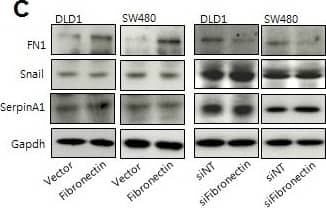 View Larger
View Larger
Detection of Human Snail by Western Blot Snail and serpinA1 promoted tumor progression through fibronectinA. DLD-1 and SW480 cells were transfected with pcDNA-Snail (Snail), control vector pcDNA (vector), Snail siRNA (siSnail), or nontargeting siRNA (siNT), and Snail, serpinA1, and fibronectin protein levels were evaluated by western blot analysis. B. DLD-1 and SW480 cells were transfected with pcDNA-serpinA1 (SerpinA1), control vector pcDNA (vector), serpinA1 siRNA (siSerpinA1), or nontargeting siRNA (siNT), and Snail, serpinA1, and fibronectin protein levels were evaluated by western blot analysis. C. DLD-1 and SW480 cells were transfected with pcDNA-fibronectin (Fibronectin), control vector pcDNA (vector), fibronectin siRNA (siFibronectin), or nontargeting siRNA (siNT), and Snail, serpinA1, and fibronectin protein levels were evaluated by western blot analysis. D., E. Invasion and migration assays were performed using transfected cells. Representative data are shown for cells that invaded (top) and migrated (bottom) in the presence of 1% FBS. *P < 0.05. Image collected and cropped by CiteAb from the following publication (https://pubmed.ncbi.nlm.nih.gov/26015410), licensed under a CC-BY license. Not internally tested by R&D Systems.
Reconstitution Calculator
Preparation and Storage
- 12 months from date of receipt, -20 to -70 °C as supplied.
- 1 month, 2 to 8 °C under sterile conditions after reconstitution.
- 6 months, -20 to -70 °C under sterile conditions after reconstitution.
Background: Snail
Snail is predicted 29 kDa nuclear zinc finger transcriptional repressor that contains an N-terminal basic SNAG domain followed by three classical and one atypical zinc finger domains. During development, Snail is required for the establishment of left-right axis asymmetry. It also regulates the transcription of E-cadherin and other genes involved in epithelial-mesenchymal transitions during cancer progression. Human Snail shares 88% amino acid sequence identity with mouse and rat Snail.
Product Datasheets
Citations for Human Snail Antibody
R&D Systems personnel manually curate a database that contains references using R&D Systems products. The data collected includes not only links to publications in PubMed, but also provides information about sample types, species, and experimental conditions.
35
Citations: Showing 1 - 10
Filter your results:
Filter by:
-
Tissue microarray analysis indicates hedgehog signaling as a potential prognostic factor in intermediate-risk prostate cancer
Authors: Gonnissen A, Isebaert S, Perneel C et al.
BMC Cancer
-
Wnt/CTNNB1 Signal Transduction Pathway Inhibits the Expression of ZFP36 in Squamous Cell Carcinoma, by Inducing Transcriptional Repressors SNAI1, SLUG and TWIST
Authors: Emma D. Zanfi, Sebastian Fantini, Roberta Lotti, Matteo Bertesi, Alessandra Marconi, Alexis Grande et al.
International Journal of Molecular Sciences
-
PDGF-mediated mesenchymal transformation renders endothelial resistance to anti-VEGF treatment in glioblastoma
Authors: T Liu, W Ma, H Xu, M Huang, D Zhang, Z He, L Zhang, S Brem, DM O'Rourke, Y Gong, Y Mou, Z Zhang, Y Fan
Nat Commun, 2018-08-27;9(1):3439.
-
Snail and serpinA1 promote tumor progression and predict prognosis in colorectal cancer.
Authors: Kwon CH, Park HJ, Choi JH et al.
Oncotarget
-
SNAIL Promotes Metastatic Behavior of Rhabdomyosarcoma by Increasing EZRIN and AKT Expression and Regulating MicroRNA Networks
Authors: Klaudia Skrzypek, Marta Kot, Paweł Konieczny, Artur Nieszporek, Anna Kusienicka, Małgorzata Lasota et al.
Cancers (Basel)
-
p53 directly activates cystatin D/CST5 to mediate mesenchymal-epithelial transition: a possible link to tumor suppression by vitamin D3
Authors: Sabine Hünten, Heiko Hermeking
Oncotarget
-
Endothelial plasticity drives aberrant vascularization and impedes cardiac repair after myocardial infarction
Authors: Menggui Huang, Fan Yang, Duo Zhang, Maohuan Lin, Hao Duan, Rakan El-Mayta et al.
Nature Cardiovascular Research
-
The transcription factor Rreb1 regulates epithelial architecture, invasiveness, and vasculogenesis in early mouse embryos
Authors: Sophie M Morgani, Jie Su, Jennifer Nichols, Joan Massagué, Anna-Katerina Hadjantonakis
eLife
-
Aberrant Activation of Notch1 Signaling in Glomerular Endothelium Induces Albuminuria
Authors: Liqun Li, Qiang Liu, Tongyao Shang, Wei Song, Dongmei Xu, Thaddeus D. Allen et al.
Circulation Research
-
The miR-5694/AF9/Snail Axis Provides Metastatic Advantages and a Therapeutic Target in Basal-like Breast Cancer
Authors: Tian X, Yu H, Li D et al.
Molecular Therapy
-
Non-apical mitoses contribute to cell delamination during mouse gastrulation
Authors: Despin-Guitard, E;Rosa, VS;Plunder, S;Mathiah, N;Van Schoor, K;Nehme, E;Merino-Aceituno, S;Egea, J;Shahbazi, MN;Theveneau, E;Migeotte, I;
Nature communications
Species: Mouse
Sample Types: Whole Tissue
Applications: Immunohistochemistry -
Nidogen-1/NID1 Function and Regulation during Progression and Metastasis of Colorectal Cancer
Authors: Rokavec, M;Jaeckel, S;Hermeking, H;
Cancers
Species: Human
Sample Types:
Applications: Chromatin Immunoprecipitation (ChIP) -
Exploring the Role of Hypoxia-Inducible Carbonic Anhydrase IX (CAIX) in Circulating Tumor Cells (CTCs) of Breast Cancer
Authors: JD Twomey, B Zhang
Biomedicines, 2023-03-17;11(3):.
Species: Human
Sample Types: Cell Lysates
Applications: Western Blot -
In�vitro attachment and symmetry breaking of a human embryo model assembled from primed embryonic stem cells
Authors: M Simunovic, ED Siggia, AH Brivanlou
Cell Stem Cell, 2022-06-02;29(6):962-972.e4.
Species: Human
Sample Types: Whole Tissue
Applications: IHC -
The miR-5694/AF9/Snail Axis Provides Metastatic Advantages and a Therapeutic Target in Basal-like Breast Cancer
Authors: Tian X, Yu H, Li D et al.
Molecular Therapy
-
Design and Functional Validation of a Mutant Variant of the LncRNA HOTAIR to Counteract Snail Function in Epithelial-to-Mesenchymal Transition
Authors: Battistelli C, Garbo S, Riccioni V et al.
Cancer Research
-
Epigenomic and Transcriptomic Changes During Human RPE EMT in a Stem Cell Model of Epiretinal Membrane Pathogenesis and Prevention by Nicotinamide
Authors: NC Boles, M Fernandes, T Swigut, R Srinivasan, L Schiff, A Rada-Igles, Q Wang, JS Saini, T Kiehl, JH Stern, J Wysocka, TA Blenkinsop, S Temple
Stem Cell Reports, 2020-04-02;14(4):631-647.
Species: Human
Sample Types: Whole Cells
Applications: ICC -
EphA5 knockdown enhances the invasion and migration ability of esophageal squamous cell carcinoma via epithelial-mesenchymal transition through activating Wnt/beta-catenin pathway
Authors: R Zhang, J Liu, W Zhang, L Hua, LT Qian, SB Zhou
Cancer Cell Int., 2020-01-13;20(0):20.
Species: Human
Sample Types: Cell Lysates
Applications: IF -
The ubiquitin-specific protease USP17 prevents cellular senescence by stabilizing the methyltransferase SET8 and transcriptionally repressing p21
Authors: K Fukuura, Y Inoue, C Miyajima, S Watanabe, M Tokugawa, D Morishita, N Ohoka, M Komada, H Hayashi
J. Biol. Chem., 2019-09-18;0(0):.
Species: Human
Sample Types: Cell Lysates
Applications: Western Blot -
Myoferlin Contributes to the Metastatic Phenotype of Pancreatic Cancer Cells by Enhancing Their Migratory Capacity through the Control of Oxidative Phosphorylation
Authors: G Rademaker, B Costanza, S Anania, F Agirman, N Maloujahmo, E Di Valenti, JJ Goval, A Bellahcène, V Castronovo, O Peulen
Cancers (Basel), 2019-06-19;11(6):.
Species: Human
Sample Types: Cell Lysates
Applications: Western Blot -
Ginsenoside Rk1 Induces Apoptosis in Neuroblastoma Cells Through Loss of Mitochondrial Membrane Potential and Activation of Caspases
Authors: JM Oh, J Lee, WT Im, S Chun
Int J Mol Sci, 2019-03-11;20(5):.
Species: Human
Sample Types: Cell Lysates
Applications: Western Blot -
The Oncogenic Activity of miR-29b-1-5p Induces the Epithelial-Mesenchymal Transition in Oral Squamous Cell Carcinoma
Authors: M Kurihara-S, T Sasahira, H Shimomura, C Nakashima, T Kirita
J Clin Med, 2019-02-24;8(2):.
Species: Human
Sample Types: Cell Lysates
Applications: Western Blot -
MDM2 promotes epithelial-mesenchymal transition and metastasis of ovarian cancer SKOV3 cells.
Authors: Ying Chen, Dan-Dan Wang, Ye-Ping Wu, Dan Su, Tian-Yi Zhou, Ren-Hua Gai, Ying-Ying Fu, Lin Zheng, Qiao-Jun He, Hong Zhu, Bo Yang
British Journal of Cancer, 2017-08-17;0(0):1532-1827.
Species: Human
Sample Types: Whole Cells
Applications: Western Blot -
Pro-invasive properties of Snail1 are regulated by sumoylation in response to TGF? stimulation in cancer.
Authors: Shyam Kumar Gudey, Reshma Sundar, Carl-Henrik Heldin, Anders Bergh, Marene Landström
Oncotarget, 2017-08-09;0(0):1949-2553.
Species: Human, Mouse
Sample Types: Cell Lysates
Applications: Immunoprecipitation -
Pan-cancer EMT-signature identifies RBM47 down-regulation during colorectal cancer progression
Authors: M Rokavec, M Kaller, D Horst, H Hermeking
Sci Rep, 2017-07-05;7(1):4687.
Species: Human
Sample Types: Cell Lysates
Applications: ChIP -
Epithelial-mesenchymal transitioned circulating tumor cells capture for detecting tumor progression.
Authors: Satelli A, Mitra A, Brownlee Z, Xia X, Bellister S, Overman M, Kopetz S, Ellis L, Meng Q, Li S
Clin Cancer Res, 2014-12-16;21(4):899-906.
Species: Human
Sample Types: Whole Cells
Applications: ICC -
SNAI1 expression and the mesenchymal phenotype: an immunohistochemical study performed on 46 cases of oral squamous cell carcinoma.
Authors: Schwock J, Bradley G, Ho JC
BMC Clin Pathol, 2010-02-05;10(0):1.
Species: Human
Sample Types: Tissue Homogenates, Whole Tissue
Applications: IHC-P, Western Blot -
Micropattern differentiation of mouse pluripotent stem cells recapitulates embryo regionalized cell fate patterning
Authors: Sophie M Morgani, Jakob J Metzger, Jennifer Nichols, Eric D Siggia, Anna-Katerina Hadjantonakis
eLife
-
Mesenchymal-epithelial transition regulates initiation of pluripotency exit before gastrulation
Authors: Sofiane Hamidi, Yukiko Nakaya, Hiroki Nagai, Cantas Alev, Takeya Kasukawa, Sapna Chhabra et al.
Development
-
Dynamic Chromatin Modification Sustains Epithelial-Mesenchymal Transition following Inducible Expression of Snail-1
Authors: Sarah Javaid, Jianmin Zhang, Endre Anderssen, Josh C. Black, Ben S. Wittner, Ken Tajima et al.
Cell Reports
-
Altered expression of epithelial-to-mesenchymal transition proteins in extraprostatic prostate cancer
Authors: Clare Verrill, Lucia Cerundolo, Chad Mckee, Michael White, Christiana Kartsonaki, Eve Fryer et al.
Oncotarget
-
Serpin peptidase inhibitor clade A member 1 is a biomarker of poor prognosis in gastric cancer.
Authors: Kwon CH, Park HJ, Lee JR et al.
Br J Cancer
-
Induced hepatic stem cells are suitable for human hepatocyte production
Authors: Yoshiki Nakashima, Chika Miyagi-Shiohira, Issei Saitoh, Masami Watanabe, Masayuki Matsushita, Masayoshi Tsukahara et al.
iScience
-
Epithelial-to-mesenchymal transition confers pericyte properties on cancer cells
Authors: Anitha K. Shenoy, Yue Jin, Huacheng Luo, Ming Tang, Christine Pampo, Rong Shao et al.
Journal of Clinical Investigation
-
Design and Functional Validation of a Mutant Variant of the LncRNA HOTAIR to Counteract Snail Function in Epithelial-to-Mesenchymal Transition
Authors: Battistelli C, Garbo S, Riccioni V et al.
Cancer Research
FAQs
No product specific FAQs exist for this product, however you may
View all Antibody FAQsReviews for Human Snail Antibody
Average Rating: 4 (Based on 5 Reviews)
Have you used Human Snail Antibody?
Submit a review and receive an Amazon gift card.
$25/€18/£15/$25CAN/¥75 Yuan/¥2500 Yen for a review with an image
$10/€7/£6/$10 CAD/¥70 Yuan/¥1110 Yen for a review without an image
Filter by:
SNAIL expression was checked with shCtr or sh-geneX to determine influences on EMT. A clear band was observed at around 30KD.
Total cell lysates from HCT-116, HeLa and PC-3 were subjected to western blot. PVDF membrane were probed with 1 um/ml Human Snail Antibody (AF3639). A specific band was detected for Snail at approximately 30 kDa. This experiment was conducted under reducing conditions.
